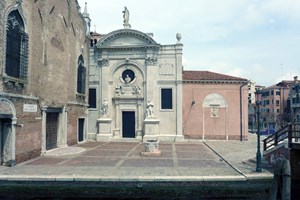
The Icelandic Art Center (IAC), in cooperation with the Ministry of Education, Science and Culture of Iceland, is proud to announce THE MOSQUE: The First Mosque in the Historic City of Venice, as its national pavilion at the 56th International Art Exhibition - La Biennale di Venezia.
At the Cannaregio church site of THE MOSQUE visitors will find the physical attributes of Muslim worship - the qibla wall, the mihrab, the minbar, and the large prayer carpet oriented in direction of Mecca – juxtaposed with the existing Catholic architecture of the Church of Santa Maria della Misericordia in a visual analog for the layering of history, religion, and culture that gives rise to both progress and conflict.
Historical facts
The City of Venice was the Mediterranean center of trade from the 13th century to the 15th century, when the Sultanate of the Ottoman Empire was establishing its presence. Complex religious and political issues dominated Venetian history, requiring the City to perform a cultural balancing act between East and West. The ongoing and diverse patterns of commercial and cultural interaction between Venice and the East rendered it the trading capital of the world for centuries – and the tourist attraction it is today. Evidence of Islamic influence is everywhere in Venice: The city’s unique and famous architecture is an amalgam of Occidental and Oriental styles. Venetian dialect is rich with Arabic words and inflections. The first mechanically printed Arabic Quran was published in Venice in 1537-38; the only remaining original resides in the city today.
THE MOSQUE draws attention to issues that connect Venice and Iceland and shape dialogue about their respective futures. Venetian problems such as the commodification of culture, complete saturation by tourists, and an ongoing depopulation of native Venetians that threatens to reduce the city to stasis, find parallels in Iceland via exponential increases in tourism, the commercialization and exploitation of nature, and low immigration rates.
THE MOSQUE: The First Mosque in the Historic City of Venice has been made possible by the Icelandic Ministry of Education, Science and Culture. Additional support for the project has been provided by Juan Carlos Verme and Joel Yoss, Hauser & Wirth, Ingunn Wernersdóttir, Promote Iceland, and Pro Helvetia.
About the Artist
Born in Basel, Switzerland in 1966, Christoph Büchel is recognized internationally for his conceptual projects and complex large-scale installations. Büchel often draws upon current events and politics, re-appropriating mass media sources and everyday life situations. His precise representations of reality seem to be more real than reality itself. Often the world he creates is fully functioning, and visitors forget that they are in an art installation, physically projected into other contexts and community settings that make up the contemporary world. These lifelike installations, which often also involve interaction and dialogue with specific communities, are often meticulous constructions that mirror the inner workings and hierarchies of advanced capitalist societies, contexts we pretend not to see or consciously refuse to acknowledge.
In Büchel’s work, complexity is found in the elaborate detail developed for each project. A hallmark of the artist’s work is layers of social and political commentary. Büchel locates contradictions and social inequities in the ideological forces dominating society today and finds a way, through his art, to demystify and resist these forces by revealing them as constructed realities subject to change.
Public Information
Information about programs of THE MOSQUE is be available online at www.mosque.is.

Photo Courtesy Icelandic Pavilion, 56th International Art Exhibition, La Biennale di Venezia
THE MOSQUE: The First Mosque in the Historic City of Venice
9 MAY – 22 NOVEMBER 2015
Santa Maria della Misericordia
Campo de l’Abazia
Cannagregio 3548/49 Venezia
Vaporetto Stops: Line 1 San Marcuola or Ca D’oro

ArtDependence Magazine is an international magazine covering all spheres of contemporary art, as well as modern and classical art.
ArtDependence features the latest art news, highlighting interviews with today’s most influential artists, galleries, curators, collectors, fair directors and individuals at the axis of the arts.
The magazine also covers series of articles and reviews on critical art events, new publications and other foremost happenings in the art world.
If you would like to submit events or editorial content to ArtDependence Magazine, please feel free to reach the magazine via the contact page.